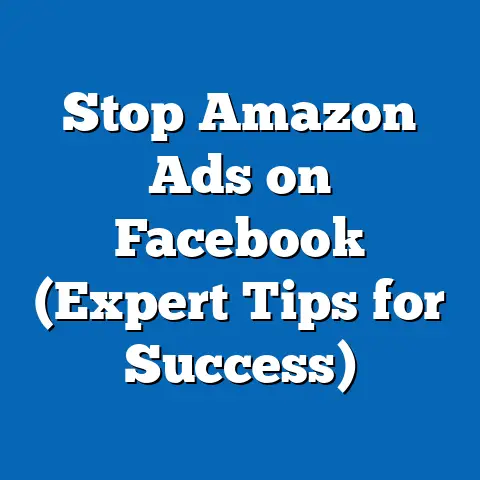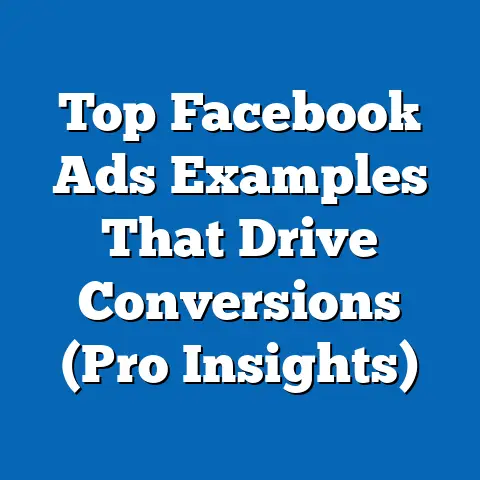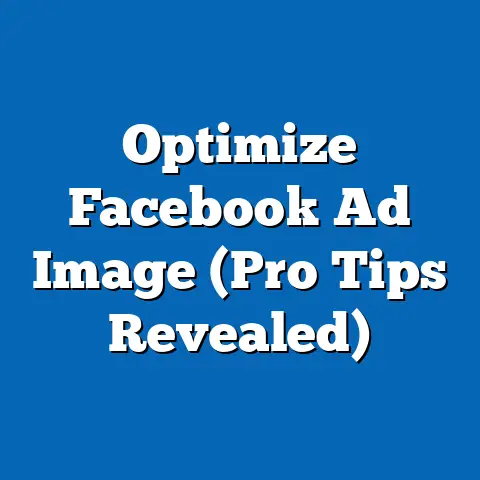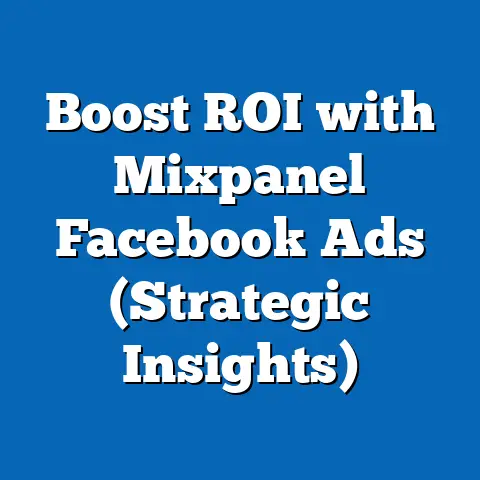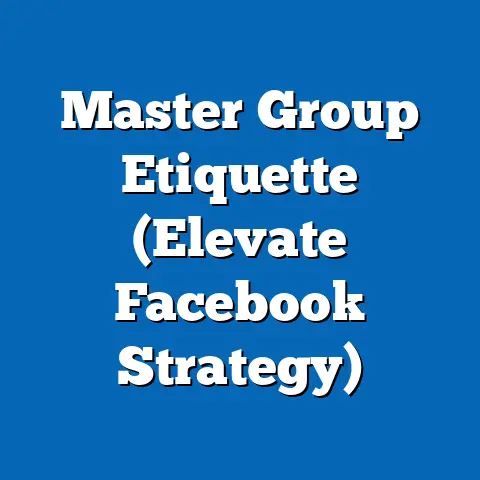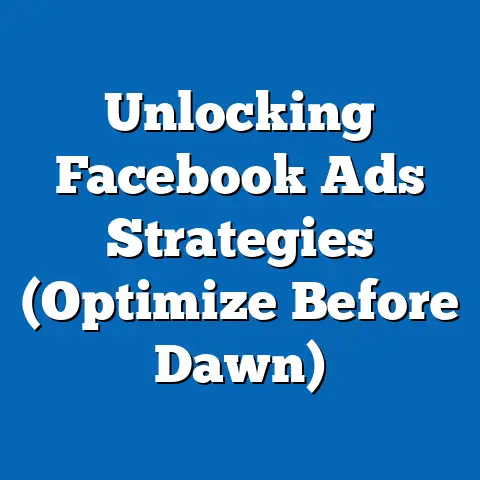View Past Facebook Ads (Unlock Valuable Insights)
As I navigate the ever-shifting sands of digital advertising, one thing remains constant: data is king. We’re no longer in an era where gut feelings and educated guesses reign supreme. Today, successful advertising hinges on data-driven strategies, and in the context of Facebook Ads, that means meticulously analyzing our past campaigns. I firmly believe that understanding our historical data, especially our past Facebook ads, isn’t just a retrospective exercise; it’s a critical tool for charting a course towards future success. Businesses and marketers who leverage these insights gain a significant edge, enhancing their ad strategies, refining their targeting, and ultimately driving better results. Let’s dive into how we can unlock these valuable insights and shape the future of our Facebook advertising.
The Importance of Historical Data in Advertising
In the world of Facebook advertising, historical data is more than just a record of what happened; it’s a roadmap to what could happen. It’s the foundation upon which we build effective, results-oriented advertising strategies. I see it as analogous to a scientist meticulously documenting experiments – each ad campaign is an experiment, and the data it generates is invaluable.
Past performance provides crucial benchmarks for future campaigns. Without understanding what worked and what didn’t, we’re essentially flying blind. Historical data allows us to identify trends, understand audience preferences, and refine our messaging to resonate more deeply. For example, I once worked with a client who consistently targeted a broad age range in their health and wellness ads. By analyzing their past campaign data, we discovered that their highest engagement and conversion rates came from individuals aged 35-50. Narrowing their target audience based on this historical insight dramatically improved their ROI.
Think about A/B testing. I’ve found that the most successful A/B tests are informed by past performance. We’re not just throwing spaghetti at the wall to see what sticks; we’re strategically testing variations based on what the data suggests will be more effective. For instance, if historical data shows that video ads consistently outperform image ads for a specific audience, that’s a strong indication that we should prioritize video content in future campaigns targeting that demographic.
Several successful brands have demonstrated the tangible benefits of using historical ad data. Consider Netflix, a master of personalization. They leverage historical viewing data to recommend content, but they also use advertising data to refine their targeting and messaging. They analyze which ads led to sign-ups, which demographics responded best, and which creatives resonated most strongly. This data informs their future ad campaigns, ensuring that they’re reaching the right people with the right message at the right time.
Another example is Amazon. They meticulously track customer behavior on their platform, and this data informs their advertising strategies. They analyze which products customers have viewed, which products they’ve purchased, and which keywords they’ve searched for. This allows them to create highly targeted ads that are incredibly relevant to individual users, leading to higher conversion rates and increased sales.
Key Takeaway: Historical data is the bedrock of effective Facebook advertising. It provides benchmarks, informs A/B testing, and allows us to understand our audience better. By analyzing past performance, we can make data-driven decisions that improve our ROI and drive business growth.
How to Access Past Facebook Ads
Accessing your past Facebook ads is a straightforward process, thanks to the robust features of Facebook Ads Manager. I’ve guided countless clients through this process, and I’m happy to share the steps here.
-
Log in to Facebook Ads Manager: Start by logging into your Facebook account and navigating to Facebook Ads Manager. You can usually find it in the left-hand menu or by searching for it in the search bar.
-
Select Your Ad Account: If you manage multiple ad accounts, make sure you select the correct one from the dropdown menu in the top right corner.
-
Navigate to the Campaigns Tab: Once you’re in the correct ad account, click on the “Campaigns” tab. This will give you an overview of all your campaigns, past and present.
-
Apply Filters and Date Ranges: This is where the real magic happens. Use the filters at the top of the screen to narrow down your search. You can filter by campaign status (active, paused, completed), delivery (delivering, learning, etc.), and objective (awareness, traffic, engagement, leads, sales). Most importantly, use the date range selector to specify the period you want to analyze.
- Pro Tip: I often find it helpful to compare different time periods. For example, you can compare the performance of your campaigns from Q1 to Q2 to identify any seasonal trends or changes in audience behavior.
-
Customize Your Columns: By default, Facebook Ads Manager displays a set of standard metrics. However, you can customize the columns to display the metrics that are most relevant to your analysis. Click on the “Columns” dropdown menu and select “Customize Columns.” Here, you can add or remove metrics such as CTR, CPC, ROI, cost per result, and engagement rates.
-
Export Your Data: If you want to perform more in-depth analysis, you can export your data to a spreadsheet. Click on the “Report” icon (usually three horizontal lines) and select “Export Table Data.” You can choose to export the data as a CSV or Excel file.
- Visual Aid: Imagine a screenshot of the Facebook Ads Manager interface, highlighting the filters, date range selector, and columns customization options. This would provide a clear visual guide for users.
Log in to Facebook Ads Manager: Start by logging into your Facebook account and navigating to Facebook Ads Manager. You can usually find it in the left-hand menu or by searching for it in the search bar.
Select Your Ad Account: If you manage multiple ad accounts, make sure you select the correct one from the dropdown menu in the top right corner.
Navigate to the Campaigns Tab: Once you’re in the correct ad account, click on the “Campaigns” tab. This will give you an overview of all your campaigns, past and present.
Apply Filters and Date Ranges: This is where the real magic happens. Use the filters at the top of the screen to narrow down your search. You can filter by campaign status (active, paused, completed), delivery (delivering, learning, etc.), and objective (awareness, traffic, engagement, leads, sales). Most importantly, use the date range selector to specify the period you want to analyze.
- Pro Tip: I often find it helpful to compare different time periods. For example, you can compare the performance of your campaigns from Q1 to Q2 to identify any seasonal trends or changes in audience behavior.
Customize Your Columns: By default, Facebook Ads Manager displays a set of standard metrics. However, you can customize the columns to display the metrics that are most relevant to your analysis. Click on the “Columns” dropdown menu and select “Customize Columns.” Here, you can add or remove metrics such as CTR, CPC, ROI, cost per result, and engagement rates.
Export Your Data: If you want to perform more in-depth analysis, you can export your data to a spreadsheet. Click on the “Report” icon (usually three horizontal lines) and select “Export Table Data.” You can choose to export the data as a CSV or Excel file.
- Visual Aid: Imagine a screenshot of the Facebook Ads Manager interface, highlighting the filters, date range selector, and columns customization options. This would provide a clear visual guide for users.
Beyond your own ad data, it’s also crucial to understand Facebook’s Ad Library. This tool allows you to view ads run by other businesses, providing valuable insights into your competitors’ strategies. You can search for ads by keyword, business name, or page name. This is incredibly useful for competitive analysis and identifying industry trends.
Key Takeaway: Facebook Ads Manager provides a wealth of data about your past campaigns. By using the filters, date range selector, and column customization options, you can access the specific information you need to analyze your performance and inform your future strategies. Don’t forget to leverage Facebook’s Ad Library to keep an eye on your competitors.
Key Metrics to Analyze
Once you’ve accessed your past Facebook ad data, the next step is to identify the key metrics that will provide the most valuable insights. I’ve found that focusing on a few core metrics is more effective than trying to analyze everything at once. Here are some of the most essential metrics to consider:
-
Click-Through Rate (CTR): This is the percentage of people who saw your ad and clicked on it. A high CTR indicates that your ad is relevant and engaging to your target audience. A low CTR, on the other hand, suggests that your ad may not be resonating with your audience or that your targeting is off. I typically aim for a CTR of at least 1% for most campaigns.
-
Cost Per Click (CPC): This is the average cost you pay each time someone clicks on your ad. A low CPC indicates that your ad is efficient and that you’re getting good value for your money. A high CPC, on the other hand, suggests that your ad may be too expensive or that your targeting is too broad. I always try to optimize my campaigns to lower the CPC while maintaining a high CTR.
-
Return on Investment (ROI): This is the ultimate measure of your advertising success. It measures the profit you generate from your ad campaigns relative to the amount you spent. A positive ROI indicates that your ad campaigns are profitable, while a negative ROI suggests that you’re losing money. I always strive for a positive ROI and continuously optimize my campaigns to improve it.
-
Engagement Rate: This measures how much people are interacting with your ad. It includes metrics such as likes, comments, shares, and saves. A high engagement rate indicates that your ad is resonating with your audience and that they’re finding it valuable. A low engagement rate, on the other hand, suggests that your ad may not be capturing their attention.
-
Conversion Rate: This is the percentage of people who clicked on your ad and then completed a desired action, such as making a purchase, filling out a form, or signing up for a newsletter. A high conversion rate indicates that your ad is effective at driving results. A low conversion rate, on the other hand, suggests that there may be issues with your landing page or that your offer isn’t compelling enough.
- Interpreting Metrics: I’ve learned that interpreting these metrics in isolation can be misleading. It’s important to consider them in relation to each other and to your overall business goals. For example, a high CTR and a low conversion rate might indicate that your ad is attracting the wrong type of traffic. Similarly, a low CTR and a high conversion rate might suggest that your ad is highly targeted but that you’re not reaching enough people.
Click-Through Rate (CTR): This is the percentage of people who saw your ad and clicked on it. A high CTR indicates that your ad is relevant and engaging to your target audience. A low CTR, on the other hand, suggests that your ad may not be resonating with your audience or that your targeting is off. I typically aim for a CTR of at least 1% for most campaigns.
Cost Per Click (CPC): This is the average cost you pay each time someone clicks on your ad. A low CPC indicates that your ad is efficient and that you’re getting good value for your money. A high CPC, on the other hand, suggests that your ad may be too expensive or that your targeting is too broad. I always try to optimize my campaigns to lower the CPC while maintaining a high CTR.
Return on Investment (ROI): This is the ultimate measure of your advertising success. It measures the profit you generate from your ad campaigns relative to the amount you spent. A positive ROI indicates that your ad campaigns are profitable, while a negative ROI suggests that you’re losing money. I always strive for a positive ROI and continuously optimize my campaigns to improve it.
Engagement Rate: This measures how much people are interacting with your ad. It includes metrics such as likes, comments, shares, and saves. A high engagement rate indicates that your ad is resonating with your audience and that they’re finding it valuable. A low engagement rate, on the other hand, suggests that your ad may not be capturing their attention.
Conversion Rate: This is the percentage of people who clicked on your ad and then completed a desired action, such as making a purchase, filling out a form, or signing up for a newsletter. A high conversion rate indicates that your ad is effective at driving results. A low conversion rate, on the other hand, suggests that there may be issues with your landing page or that your offer isn’t compelling enough.
- Interpreting Metrics: I’ve learned that interpreting these metrics in isolation can be misleading. It’s important to consider them in relation to each other and to your overall business goals. For example, a high CTR and a low conversion rate might indicate that your ad is attracting the wrong type of traffic. Similarly, a low CTR and a high conversion rate might suggest that your ad is highly targeted but that you’re not reaching enough people.
A/B testing results are also crucial. I always recommend A/B testing different ad elements, such as headlines, images, and calls to action, to see which ones resonate best with your target audience. By analyzing the results of these tests, you can identify the ad elements that are most effective and incorporate them into your future campaigns.
Key Takeaway: Analyzing key metrics such as CTR, CPC, ROI, engagement rate, and conversion rate is essential for understanding the effectiveness of your past Facebook ad campaigns. By interpreting these metrics in relation to each other and to your overall business goals, you can gain valuable insights that will inform your future strategies.
Case Studies of Learning from the Past
To illustrate the power of learning from past Facebook ads, let’s examine a couple of case studies. These examples highlight how brands have effectively utilized historical data to drive future campaigns.
Case Study 1: The E-commerce Fashion Brand
-
The Challenge: An e-commerce fashion brand was struggling to generate consistent sales through their Facebook ad campaigns. They were running a variety of ads targeting different demographics, but their ROI was inconsistent.
-
The Implementation: Based on this insight, they shifted their focus to UGC. They launched a campaign encouraging customers to submit photos of themselves wearing their products in exchange for a discount on their next purchase. They then used these photos in their Facebook ads.
-
The Results: The UGC-focused ads generated a 30% increase in CTR and a 20% increase in conversion rate. Their ROI improved significantly, and they were able to generate consistent sales through their Facebook ad campaigns.
- Lesson Learned: User-generated content can be incredibly effective for e-commerce brands. By leveraging the authenticity and relatability of UGC, they can build trust with their audience and drive sales.
The Challenge: An e-commerce fashion brand was struggling to generate consistent sales through their Facebook ad campaigns. They were running a variety of ads targeting different demographics, but their ROI was inconsistent.
The Implementation: Based on this insight, they shifted their focus to UGC. They launched a campaign encouraging customers to submit photos of themselves wearing their products in exchange for a discount on their next purchase. They then used these photos in their Facebook ads.
The Results: The UGC-focused ads generated a 30% increase in CTR and a 20% increase in conversion rate. Their ROI improved significantly, and they were able to generate consistent sales through their Facebook ad campaigns.
- Lesson Learned: User-generated content can be incredibly effective for e-commerce brands. By leveraging the authenticity and relatability of UGC, they can build trust with their audience and drive sales.
Case Study 2: The Local Restaurant
-
The Challenge: A local restaurant was struggling to attract new customers through their Facebook ad campaigns. They were running ads promoting their menu and special offers, but their reach was limited, and their engagement was low.
-
The Analysis: By analyzing their past campaign data, they discovered that their most successful ads were those that focused on community engagement. These ads featured photos of local events they sponsored and highlighted their involvement in the community.
-
The Implementation: Based on this insight, they shifted their focus to community engagement. They launched a campaign promoting a local charity and offered a discount to customers who donated. They also sponsored a local sports team and featured photos of the team in their Facebook ads.
-
The Results: The community engagement-focused ads generated a 50% increase in reach and a 40% increase in engagement. They attracted a significant number of new customers, and their brand awareness improved significantly.
- Lesson Learned: Local businesses can benefit from focusing on community engagement in their Facebook ad campaigns. By highlighting their involvement in the community, they can build relationships with local residents and attract new customers.
The Challenge: A local restaurant was struggling to attract new customers through their Facebook ad campaigns. They were running ads promoting their menu and special offers, but their reach was limited, and their engagement was low.
The Analysis: By analyzing their past campaign data, they discovered that their most successful ads were those that focused on community engagement. These ads featured photos of local events they sponsored and highlighted their involvement in the community.
The Implementation: Based on this insight, they shifted their focus to community engagement. They launched a campaign promoting a local charity and offered a discount to customers who donated. They also sponsored a local sports team and featured photos of the team in their Facebook ads.
The Results: The community engagement-focused ads generated a 50% increase in reach and a 40% increase in engagement. They attracted a significant number of new customers, and their brand awareness improved significantly.
- Lesson Learned: Local businesses can benefit from focusing on community engagement in their Facebook ad campaigns. By highlighting their involvement in the community, they can build relationships with local residents and attract new customers.
Key Takeaway: These case studies demonstrate the power of learning from past Facebook ads. By analyzing their historical data, these brands were able to identify what was working and what wasn’t, and they implemented changes that significantly improved their performance. Past performance is a valuable teacher for future strategies.
Future Trends in Facebook Advertising
Looking ahead, the landscape of Facebook advertising is poised for further evolution. I believe it’s crucial to stay abreast of emerging trends to ensure our campaigns remain effective and aligned with consumer behavior. Here are some key trends I’m watching closely:
-
AI-Driven Ad Targeting: Artificial intelligence (AI) is already playing a significant role in Facebook advertising, and its influence is only going to grow. AI-powered tools can analyze vast amounts of data to identify the most relevant audiences for our ads, predict which ads are most likely to convert, and automate ad optimization. I anticipate that AI will become even more sophisticated in the future, allowing us to create hyper-personalized ad experiences that are tailored to individual users.
-
Personalized Content: Consumers are increasingly demanding personalized experiences, and Facebook advertising is no exception. In the future, I believe we’ll see a greater emphasis on creating personalized ad content that is tailored to individual users’ interests, preferences, and behaviors. This could involve using dynamic creative optimization (DCO) to automatically generate different ad variations based on user data or creating custom audiences based on specific user segments.
-
The Growing Role of Video Ads: Video ads are already incredibly popular on Facebook, and I expect their importance to continue to grow. Video is a highly engaging format that can capture attention and convey complex messages in a concise and compelling way. I anticipate that we’ll see a rise in the use of short-form video ads, vertical video ads, and interactive video ads in the future.
-
Augmented Reality (AR) Ads: While still in its early stages, augmented reality (AR) advertising has the potential to revolutionize the way we interact with brands on Facebook. AR ads allow users to virtually try on products, explore virtual environments, and interact with brands in new and engaging ways. I believe that AR ads will become increasingly popular in the future, especially for e-commerce brands.
AI-Driven Ad Targeting: Artificial intelligence (AI) is already playing a significant role in Facebook advertising, and its influence is only going to grow. AI-powered tools can analyze vast amounts of data to identify the most relevant audiences for our ads, predict which ads are most likely to convert, and automate ad optimization. I anticipate that AI will become even more sophisticated in the future, allowing us to create hyper-personalized ad experiences that are tailored to individual users.
Personalized Content: Consumers are increasingly demanding personalized experiences, and Facebook advertising is no exception. In the future, I believe we’ll see a greater emphasis on creating personalized ad content that is tailored to individual users’ interests, preferences, and behaviors. This could involve using dynamic creative optimization (DCO) to automatically generate different ad variations based on user data or creating custom audiences based on specific user segments.
The Growing Role of Video Ads: Video ads are already incredibly popular on Facebook, and I expect their importance to continue to grow. Video is a highly engaging format that can capture attention and convey complex messages in a concise and compelling way. I anticipate that we’ll see a rise in the use of short-form video ads, vertical video ads, and interactive video ads in the future.
Augmented Reality (AR) Ads: While still in its early stages, augmented reality (AR) advertising has the potential to revolutionize the way we interact with brands on Facebook. AR ads allow users to virtually try on products, explore virtual environments, and interact with brands in new and engaging ways. I believe that AR ads will become increasingly popular in the future, especially for e-commerce brands.
Connecting these trends to the importance of revisiting past ad data is crucial. By analyzing our past campaigns, we can identify which types of content, targeting strategies, and ad formats have been most effective. This information can then be used to inform our future campaigns, ensuring that we’re aligned with evolving consumer behaviors and technological advancements.
Key Takeaway: The future of Facebook advertising is characterized by AI-driven targeting, personalized content, the growing role of video ads, and the emergence of AR ads. By revisiting our past ad data and staying abreast of these trends, we can ensure that our campaigns remain effective and aligned with the evolving landscape of Facebook advertising.
Conclusion
In closing, I want to reiterate the significance of viewing past Facebook ads as a strategic advantage, not merely a historical record. The insights gleaned from past campaigns empower us to anticipate future trends and craft more effective, engaging, and ultimately successful advertising strategies.
By embracing this practice as an integral part of our long-term advertising strategy, we’re positioning ourselves for sustained success. The ability to learn from our experiences, adapt to changing consumer behaviors, and leverage emerging technologies is what will differentiate the winners from the losers in the competitive world of Facebook advertising. So, let’s commit to analyzing our past, embracing the future, and driving our businesses forward with data-driven decisions.

